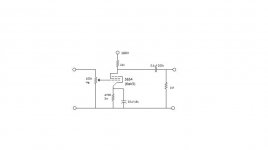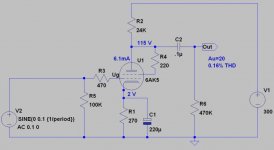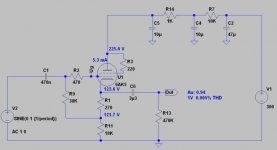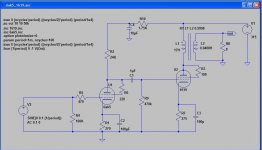Finally I decided to start projecting a new line stage with 5654, unfortunately I’ve got 35 of this tubes and in Naples the garbage collection is a main problem now so… I’ve to use them!!! Moreover this is the first time for me and I’m sure that 35 tubes are not enough before i get the goal. Therefore I need some help from you , this is the schema I’ve designed, please give it a look and give me any useful correction and/or suggestion.
Thanks
Francesco
Thanks
Francesco
Attachments
The 6AK5 was designed for low noise amplification of low-level VHF/UHF signals. Audio distortion was not a consideration. Triode connection will help, but I would not use it for a line stage without cathode degeneration. In fact, I would not use it for a line stage at all. However, you are likely to get lots of second-order distortion so it may sound "warm".
Hello,Try this operating point.
Does your Spice program do FFT outputs to show distortion?
The 0.16% noted in the attachment is not lots of distortion.
Your selection of operating point looks like it should work well.
DT
All just for fun!
LTSpice.Does your Spice program do FFT outputs to show distortion?
Run this SPICE directive for THD logging:
.option plotwinsize=0
.param period=1m, ncycles=100
;tran 0 {ncycles*period} {(ncycles/2)*period} {period/1e4}
.four {1/period} 9 -1 V(Out)
View Fourier components /9 harmonics/ of V(Out) in SPICE Error Log.
The 6AK5 was designed for low noise amplification of low-level VHF/UHF signals.
So?
Audio distortion was not a consideration.
It wasn't a consideration for the design of the vast, vast, vast majority of VT types out there. Even those types that have the rep for sonic excellence, such as the 6SN7, were designed for other purposes. Just essssssss-loads of 6SN7s were used in early radar sets and the first electronic computers. 6SN7s also showed up as vertical deflection oscillators/amps in TV sets, eventually resulting in the 6SN7GTB, with hardened control grids to stand up to positive Vgk operation, and with the plate dissipation raised from 3.5W to 5W as TV screens grew larger.
The 6BQ7 was another type designed for use as a VHF small signal amp (good to 300MHz) with absolutely zero audio pretense, as this type of operation is never mentioned in the spec sheet for the type. Well, guess what? They sound great in the right applications.
That old reliable audio work horse, the 6AU6, was originally intended for use as an RF amp.
How any one specific type sounds has more to do with loadlines and application, rather than for what it was originally designed. Some RF types, large signal/small signal, can sound great; some will sound like
An externally hosted image should be here but it was not working when we last tested it.
no matter what you do.Other specialized types that have no audio pretensions (e.g. horizontal deflection types -- 6BQ6GTA sound just as good as the famous 6V6, and put out twice the power: no audio operating points mentioned in the spec sheet) can work just fine. Finding these audio "sleepers" is well worth it since they aren't audiophool expensive (yet).
Worth a try.
A line stage can expect to see 100's of mV coming in, maybe up to 2V from CD. A 6AK5 will struggle with that amount of input signal, as the window between grid current and cutoff is quite narrow. As I said, triode connection will help. With other more robust valves you can just increase the anode volts to widen the input window, but as the 6AK5 is a UHF valve it has limited voltage capability. It has small clearances in order to reduce transit time. As far as I can see the only valid reason to use one in a line stage is that it is all you have available.
The 6AU6/EF94 has audio uses specifically mentioned in some data sheets e.g. Lorenz.
Most general-purpose valves can be used for audio. Valves developed for a specific RF application are sometimes less useful for audio, unless you like listening to the second-order distortion created by remote-cutoff (for example). RF valves, intended for small-signal inputs, can usefully be used for similar applications in audio (e.g. MM input). I might consider using the 6AK5 as a phono input, but not a line stage.
The 6AU6/EF94 has audio uses specifically mentioned in some data sheets e.g. Lorenz.
Most general-purpose valves can be used for audio. Valves developed for a specific RF application are sometimes less useful for audio, unless you like listening to the second-order distortion created by remote-cutoff (for example). RF valves, intended for small-signal inputs, can usefully be used for similar applications in audio (e.g. MM input). I might consider using the 6AK5 as a phono input, but not a line stage.
Hello,
The 6AK5 triode connected plate curves look like it can be biased for 2 volt input to me.
http://www.mif.pg.gda.pl/homepages/frank/sheets/138/5/5654.pdf (see the last page)
The 6J4 also designed for mV RF input duty has quite a following as a driver tube in the Darling amplifier. Also remember the 6DJ8 began its career as a cascode RF amplifier as well, then the data sheets were changed to keep up.
DT
All just for fun!
The 6AK5 triode connected plate curves look like it can be biased for 2 volt input to me.
http://www.mif.pg.gda.pl/homepages/frank/sheets/138/5/5654.pdf (see the last page)
The 6J4 also designed for mV RF input duty has quite a following as a driver tube in the Darling amplifier. Also remember the 6DJ8 began its career as a cascode RF amplifier as well, then the data sheets were changed to keep up.
DT
All just for fun!
Thanks everybody for the comments and info, honestly I've a bunch of this tubes and I'm triyng to understand if I can use them not only for a CD Buffer stage (http://www.diyaudio.com/forums/tubes-valves/96681-tube-buffer-6j1-5654-6ak5.html).
Looking at the curves of this tubes I already realized that the main issue is the input signal, 2V is little bit high ! Unfortunately I'm not so good in theroetical issues, and may be some alternative idea may take these tubes to a different life.
To me the curves in triode mode looks good enough, what I don't see a good idea is to use it as pentode.
I know that in triode mode the gain is low, but this is what I want, at the moment I've a 300B amplifier with a 6SN7 line stage in mu-follower configuration, and to me the gain is too high.
For sure any tube may be better, but why don't try it? It wouldn't be the best line stage but, as any other tube, it could have his character!!
So let's go on with ideas, in a couple of week I would start building a first prototype.
Thanks again.
Looking at the curves of this tubes I already realized that the main issue is the input signal, 2V is little bit high ! Unfortunately I'm not so good in theroetical issues, and may be some alternative idea may take these tubes to a different life.
To me the curves in triode mode looks good enough, what I don't see a good idea is to use it as pentode.
I know that in triode mode the gain is low, but this is what I want, at the moment I've a 300B amplifier with a 6SN7 line stage in mu-follower configuration, and to me the gain is too high.
For sure any tube may be better, but why don't try it? It wouldn't be the best line stage but, as any other tube, it could have his character!!
So let's go on with ideas, in a couple of week I would start building a first prototype.
Thanks again.
It is a nice tube. It can work on very low anode voltages. When triode connected it is very similar to 6S1P tube:
http://www.cqham.ru/tubes/soviet/pdf/6s1p.pdf
http://www.cqham.ru/tubes/soviet/pdf/6s1p.pdf
I have now had a look at the triode curves, as suggested by DT. Triode connection seems to improve things more than I expected, so you could use it as a line stage although there is not much margin for error and the gain would be rather high. An active load would help reduce distortion. So perhaps I was wrong, but not seriously wrong?
Hello,
The 6AK5 triode connected plate curves look like it can be biased for 2 volt input to me.
http://www.mif.pg.gda.pl/homepages/frank/sheets/138/5/5654.pdf (see the last page)
Hmmm... I tried again, but it still says, "Page not found"...
Hello francolacc,
A Mu-Follower is a example of a classic actively loaded common cathode amplifier. The top triode is the active load.
The Valve Wizard -Mu Follower
For starters keep it simple try the circuit in post number 3. You will need a capacitor at the input ~ 0.47 uf. You will like the results.
DT
All just for fun!
A Mu-Follower is a example of a classic actively loaded common cathode amplifier. The top triode is the active load.
The Valve Wizard -Mu Follower
For starters keep it simple try the circuit in post number 3. You will need a capacitor at the input ~ 0.47 uf. You will like the results.
DT
All just for fun!
Try this operating point.
Hi Euro21!
As I have some 6ak5 , rca 1619 sitting around in my tool box, I am tempted to build a SE amp based on your design. However, it seems to be difficult to sequeeze more than 1W or so from 1619 triode mode. Do you have any recommendation of 1619 working point?
Attachments
I finished a first prototype right now, and..... WORKS! It's still without a transformer since I'm waiting for it and was too impatient, but I've to say that the result is good. As soon as I've the transformer I'll test it and after I'll build the definitive 5654 line amplifier. I'm also planning to make a second stage with a cathode follower, I've to think about witch tube use... do you think that a 5654 should be a goof one? If so please help me with some example. Anyway the schema is the one at post 3.
- Status
- This old topic is closed. If you want to reopen this topic, contact a moderator using the "Report Post" button.
- Home
- Amplifiers
- Tubes / Valves
- 5654 (6ak5) line stage in triode mode



